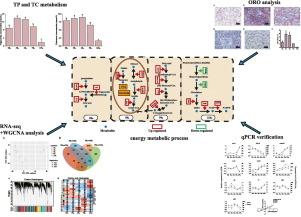整合转录组和加权基因共表达网络分析揭示了大口黑鲈在高渗应激下的肝脏代谢反应
IF 3.9
1区 农林科学
Q1 FISHERIES
引用次数: 0
摘要
大口黑鲈(Micropterus salmoides)是中国具有较高市场价值的珍贵淡水鱼种。以前的研究表明,这种鱼可以在微咸水中养殖。然而,关于高渗胁迫下大口黑鲈能量代谢途径的变化,目前还缺乏详细的研究资料。在本研究中,我们对不同盐度(0‰、3‰、6‰、9‰和12‰)条件下的大口黑鲈生长性能和肝脏转录组进行了比较分析。通过差异基因表达分析和加权基因共表达网络分析的综合分析方法表明,蛋白质代谢、糖酵解、三羧酸循环、脂肪酸氧化分解代谢和氧化磷酸化途径在大口黑鲈对高渗胁迫的响应中起关键作用。结果表明,随着盐度的升高,大口黑鲈的主要能量代谢模式发生了变化,能量需求由多种能量代谢途径的组合来满足。3‰盐度组鱼的增重率和脂肪沉积最高,而12‰盐度组对鱼的生理有严重的毒性影响,包括生长抑制和肝脏氧化损伤(抗氧化相关基因包括gpx和gsr显著上调)。综上所述,不同盐度下鱼类能量代谢的重塑最终影响了生长。本研究为研究高渗胁迫对大口黑鲈生长的影响提供了新的视角,为提高大口黑鲈对咸淡水环境的适应能力奠定了基础。本文章由计算机程序翻译,如有差异,请以英文原文为准。

Integrated transcriptome and weighted gene co-expression network analyses reveal hepatic metabolic response of largemouth bass (Micropterus salmoides) under hypertonic stress
Largemouth bass (Micropterus salmoides) is a valuable freshwater species with a high market value in China. Previous studies have suggested that this fish can be cultured in brackish water. However, there is still a lack of detailed information about the changes in energy metabolic pathways in largemouth bass under hyperosmotic stress. In this study, we conducted a comparative analysis of the growth performance and liver transcriptomes of largemouth bass cultured at a range of salinity levels (0 ‰, 3 ‰, 6 ‰, 9 ‰, and 12 ‰). A comprehensive analytical approach encompassing differential gene expression analysis and weighted gene co-expression network analysis demonstrated that protein metabolism, glycolysis, the tricarboxylic acid cycle, fatty acid oxidative catabolism, and oxidative phosphorylation pathways play pivotal roles in the response of largemouth bass to hyperosmotic stress. Our results show that the main energy metabolic patterns of largemouth bass changed as the salinity level increased, and the energy demands were met by a combination of multiple energy metabolic pathways. Fish in the 3 ‰ salinity group showed the highest WGR and fat deposition, whereas salinity at 12 ‰ had severe toxic effects on fish physiology, including growth inhibition and oxidative damage to the liver (Significant upregulation of antioxidant-related genes included gpx and gsr). In conclusion, the remodeling of fish energy metabolism under differing salinities ultimately affects growth. Our findings offer a new perspective on the impact of hyperosmotic stress on the growth of largemouth bass and establish a foundation for enhancing the adaptation of this species to brackish water environments.
求助全文
通过发布文献求助,成功后即可免费获取论文全文。
去求助
来源期刊

Aquaculture
农林科学-海洋与淡水生物学
CiteScore
8.60
自引率
17.80%
发文量
1246
审稿时长
56 days
期刊介绍:
Aquaculture is an international journal for the exploration, improvement and management of all freshwater and marine food resources. It publishes novel and innovative research of world-wide interest on farming of aquatic organisms, which includes finfish, mollusks, crustaceans and aquatic plants for human consumption. Research on ornamentals is not a focus of the Journal. Aquaculture only publishes papers with a clear relevance to improving aquaculture practices or a potential application.
 求助内容:
求助内容: 应助结果提醒方式:
应助结果提醒方式:


